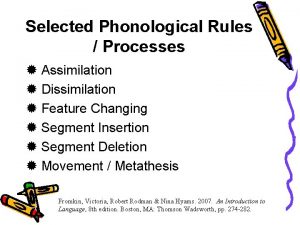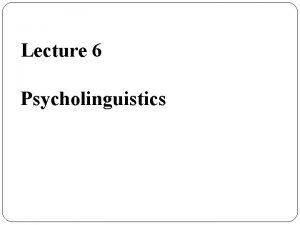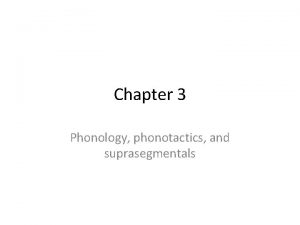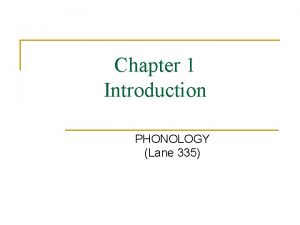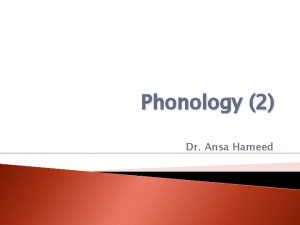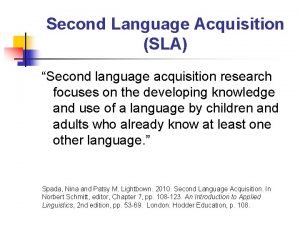Phonology in language teaching Phonology in second language

















- Slides: 17

Phonology in language teaching: Phonology in second language teaching/learning presented by: Salmah Alsulami

objectives To understand: Teachers role in pronouncing English words. How can we pronounce English correctly? ! by covering stress, pitch and intonation What is the hardest part of learning a new language ?

What is phonology? Phonology is the study of how sounds are organized and used in natural languages second-language learning is the process by which people learn a second language.

In English language learning, it is important for teacher to teach students on how to pronounce English words correctly. This is because mispronouncing the words will mislead the listener.

For example, the word “great …which is supposed to be pronounced /greit/ is pronounced /grit/, the word ‘answer’ which is supposed to be pronounced /ænsə/ is pronounced / ænswə /.

In pronouncing English words, Teachers must: *be familiar with places of articulation in English such as: stop, fricative, affricative, nasal, and liquid. *must know the manner of articulation as well such as: glide, labial, labiodental, interdental, alveolar, velar, and glottal.

phonology is not always about pronouncing English correctly but it also covers stress, pitch and intonation. Stress, pitch, and intonation in English give different color to the words uttered.

For instance, in conversation, to form question, it is not necessarily required in form of question. For instance “so, you are leaving? ” I think introducing pitch, stress, and intonation to the students are very important because it will make their English language skill particularly speaking skill more fluently and more natural.

However, in determining the stress, teachers should be careful since it will change the class of the word or it will even change the meaning of the word. For instance, the word /record/ for noun and /record/ for verb are both pronounced differently.

learning phonology will help teacher minimizing errors in pronouncing and articulating English words.

Some researchers, like A. Z. Guirora, argue that the hardest part of learning a new language is pronunciation, which can result in a "foreign accent".

There is a view by some that accents are caused by transfer between the sounds of the first and second languages, for which there are three possibilities:

1 - One or more phonemes of the second language are not found in the learner's native language at all. For example, Korean does not have any phonemes corresponding to the English phonemes /f/ or /v/, so they would be completely new to Korean learners of English.

2 -The first language has one of the two contrasting phonemes. For example, Japanese has a /p/ sound as in the English paid, but no /f/ sound as in the English fade. Japanese learners of English need to learn a new phoneme.

3 -The second language phonemes both exist in the native language, but as allophones of the same phoneme. For example, in Japanese, [l] and [r] are allophones so Japanese learners of English need to learn to distinguish these sounds.

Totally new sounds do not always pose significant problems for second-language learners, unless they are radically outside the classes of sound in the native language. The most difficult phoneme pairs to learn are often allophones of the same phoneme, as in Japanese learning to distinguish between /l/ and /r/.

References Cook, Vivian (2008). Second Language Learning and Language Teaching. London http: //en. wikipedia. org/wiki/Second- language_acquisition
 27 miles per gallon into kilometers per liter
27 miles per gallon into kilometers per liter Monitor model
Monitor model Difference between second language and foreign language
Difference between second language and foreign language Difference of first language and second language
Difference of first language and second language Difference of first language and second language
Difference of first language and second language Scale down teaching
Scale down teaching What is speech sounds in phonetics
What is speech sounds in phonetics Dissimilation meaning
Dissimilation meaning Difference between phonetics and phonology
Difference between phonetics and phonology Onset coda nucleus
Onset coda nucleus Onset coda and nucleus
Onset coda and nucleus Phonology
Phonology Dissimilation phonetics
Dissimilation phonetics Vowel phonological processes
Vowel phonological processes Phonetics and phonology
Phonetics and phonology Introduction to english linguistics exercises answers
Introduction to english linguistics exercises answers Non segmental phonology
Non segmental phonology Drc model of reading
Drc model of reading







